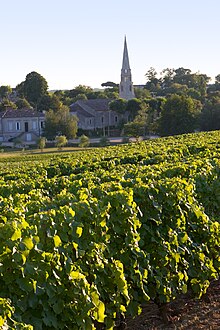Sauternes (wine region)
Sauternes is a French wine-growing region and is known for its noble sweet white wine . It belongs to the Bordeaux growing region .
The place Sauternes
In the eponymous municipality of Sauternes there are 1669 hectares and 605 hectares in Barsac . The small river Ciron flows through Sauternes, the cold spring water of which pours into the warmer water of the Garonne and forms fog in autumn , which offers good conditions for the noble rot fungus Botrytis cinerea to increase the sugar content of the grapes . In contrast to the Vin Doux Naturel such as Banyuls or Rivesaltes , the production of non-alcoholic sweet wines is the rule in the AOC Sauternes. The best and most famous winery is the Château d'Yquem .
The appellation is reserved for five municipalities (Sauternes, Barsac, Preignac , Bommes and Fargues ). The regulations set a minimum alcohol content of 13 percent. In addition, a taste test is given every year to confirm the required sweetness.
Sauternes wines are made from the Sémillon , Sauvignon Blanc and Muscadelle grape varieties . The main variety with around 70 to 80 percent share is the Sémillon grape, as it is particularly susceptible to noble rot. The Sauvignon Blanc with 20 to 30 percent gives the wines the necessary acidity so that the full, broad taste of the Sémillon is complemented accordingly. Muscadelle is used sporadically for its aroma.
The effort and risk for this Sauternes wine is high, the yields extremely low. The yield is limited to a maximum of 25 hl / ha, Yquem comes to an average yield of 9 hl / ha. The harvest is also very complex and must be carried out in several passes from the end of September to mid-November. In some years (as happened in 1978 and 1985, for example) there is no noble rot at all.
In 1985, a cellar technology called cryo-extraction was introduced. The grapes are frozen in a chamber 20 hours before pressing and pressed in the frozen state. Large amounts of water and unripe aromas are retained, making the must more concentrated. In its natural form, ice wines are concentrated by early night frosts and immediate pressing. Cryo-extraction is an expensive process and is only worthwhile for saving very humid vintages.
The Jefferson Wine
It is unclear when production of the sweet wines began. For a while, it was asserted that Thomas Jefferson had already bought wines from Château d'Yquem at the end of the 18th century. In 1787 he ordered 250 bottles of the excellent 1784 vintage. In 1985, wine collector Hardy Rodenstock spread the story that he had been offered a never-specifically named number of bottles of this vintage in Paris, which because of the engraved Th.J. Jefferson's property can be attributed to who had been ambassador to Paris from 1785 to 1789. The tasting of one of these bottles and that of a bottle from 1747 showed that it was already a sweet wine.
In the same year, the Thomas Jefferson Memorial Foundation , among others, had doubts about this story, but went unheard, as the story was too beautiful for wine lovers and producers. In 1991, a laboratory on behalf of the wine collector Hans-Peter Frericks proved that the wine in one of these Jefferson bottles must have come from the time after the first nuclear tests - i.e. after July 16, 1945. The legal dispute then initiated by Frericks against Rodenstock ended in a settlement, the details of which were agreed to be confidential.
Another wine collector, William Koch, the owner of the Osbow Group , also commissioned appraisals to have his four bottles, which he bought in 1988 for half a million dollars, examined. The most serious finding concerns the engravings, which, according to the experts, come from a modern electric drill such as is used in dental practices. Koch went to court on August 31, 2006, and the parties like to argue about this and often in relevant wine and gourmet magazines, in which Rodenstock mainly objects that Koch did not buy this wine from him.
Classification from 1855
In 1855, among other things, the noble sweet white wines from the communities of Sauternes and Barsac were classified .
Premier Cru Supérieur
This class is reserved for the Château d'Yquem (Sauternes) alone.
Premier Cru Classé
- Château La Tour Blanche (Bommes, Sauternes)
- Château Lafaurie-Peyraguey (Bommes, Sauternes)
- Clos Haut-Peyraguey (Bommes, Sauternes)
- Château Rayne Vigneau (Bommes, Sauternes)
- Château Suduiraut (Preignac, Sauternes)
- Château Coutet (Barsac)
- Château Climens (Barsac)
- Château Guiraud (Sauternes)
- Château Rieussec (Fargues, Sauternes)
- Château Rabaud celebrities (Bommes, Sauternes)
- Château Sigalas-Rabaud (Bommes, Sauternes)
Deuxième Cru Classé
- Château de Myrat (Barsac)
- Château Doisy Daëne (Barsac)
- Château Doisy-Dubroca (Barsac)
- Château Doisy-Védrines (Barsac)
- Château d'Arche (Sauternes)
- Château Filhot (Sauternes)
- Château Broustet (Barsac)
- Château Nairac (Barsac)
- Château Caillou (Barsac)
- Château Suau (Barsac)
- Château de Malle (Preignac, Sauternes)
- Château Romer du Hayot (Fargues, Sauternes)
- Château Romer (Fargues, Sauternes)
- Château Lamothe (Sauternes)
- Château Lamothe-Guignard (Sauternes)
In addition to these wineries, Château Raymond-Lafon should also be mentioned. This estate works at the level of a Premier Cru Classé, but was only founded shortly before the classification of 1855.
See also the article Bordeaux classification .
General
The steamship SS Sauternes , which sank in 1942, was named after the place .
Remarks
- ↑ see for example: Wein Gourmet 04/2006, p. 8 and Vinum 12/2006

